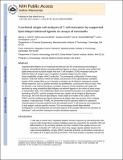| dc.contributor.author | Torres, Alexis J. | |
| dc.contributor.author | Contento, Rita Lucia | |
| dc.contributor.author | Gordo, Susana | |
| dc.contributor.author | Wucherpfennig, Kai W. | |
| dc.contributor.author | Love, John C | |
| dc.date.accessioned | 2014-11-17T18:29:45Z | |
| dc.date.available | 2014-11-17T18:29:45Z | |
| dc.date.issued | 2012-09 | |
| dc.date.submitted | 2012-07 | |
| dc.identifier.issn | 1473-0197 | |
| dc.identifier.issn | 1473-0189 | |
| dc.identifier.uri | http://hdl.handle.net/1721.1/91597 | |
| dc.description.abstract | Supported lipid bilayers are an important biomolecular tool for characterizing immunological synapses. Immobilized bilayers presenting tethered ligands on planar substrates have yielded both spatio-temporal and structural insights into how T cell receptors (TCRs) reorganize during the initial formation of synapses upon recognition of peptide antigens bound to major histocompatibility complex (MHC) molecules. The prototypical configuration of these assays, however, limits the extent to which the kinetics and structure of the supramolecular activation clusters of the synapse (that occur in seconds or minutes) can be related to subsequent complex cellular responses, such as cytokine secretion and proliferation, occurring over hours to days. Here we describe a new method that allows correlative measures of both attributes with single-cell resolution by using immobilized lipid bilayers and tethered ligands on the surface of dense arrays of subnanoliter wells. This modification allows each nanowell to function as an artificial antigen-presenting cell (APC), and the synapses formed upon contact can be imaged by fluorescence microscopy. We show that the lipid bilayers remain stable and mobile on the surface of the PDMS, and that modifying the ligands tethered to the bilayer alters the structure of the resulting synapses in expected ways. Finally, we demonstrate that this approach allows the subsequent characterization of secreted cytokines from the activated human T cell clones by microengraving in both antigen- and pan-specific manners. This new technique should allow detailed investigations on how biophysical and structural aspects of the synapse influence the activation of individual T cells and their complex functional responses. | en_US |
| dc.description.sponsorship | National Institute of Allergy and Infectious Diseases (U.S.) (5P01AI045757) | en_US |
| dc.description.sponsorship | National Cancer Institute (U.S.) (Cancer Center Support (Core) Grant P30-CA14051) | en_US |
| dc.language.iso | en_US | |
| dc.publisher | Royal Society of Chemistry | en_US |
| dc.relation.isversionof | http://dx.doi.org/10.1039/c2lc40869d | en_US |
| dc.rights | Creative Commons Attribution-Noncommercial-Share Alike | en_US |
| dc.rights.uri | http://creativecommons.org/licenses/by-nc-sa/4.0/ | en_US |
| dc.source | PMC | en_US |
| dc.title | Functional single-cell analysis of T-cell activation by supported lipid bilayer-tethered ligands on arrays of nanowells | en_US |
| dc.type | Article | en_US |
| dc.identifier.citation | Torres, Alexis J., Rita Lucia Contento, Susana Gordo, Kai W. Wucherpfennig, and J. Christopher Love. “Functional Single-Cell Analysis of T-Cell Activation by Supported Lipid Bilayer-Tethered Ligands on Arrays of Nanowells.” Lab Chip 13, no. 1 (2012): 90. | en_US |
| dc.contributor.department | Massachusetts Institute of Technology. Department of Chemical Engineering | en_US |
| dc.contributor.department | Koch Institute for Integrative Cancer Research at MIT | en_US |
| dc.contributor.mitauthor | Torres, Alexis J. | en_US |
| dc.contributor.mitauthor | Contento, Rita Lucia | en_US |
| dc.contributor.mitauthor | Love, J. Christopher | en_US |
| dc.relation.journal | Lab on a Chip | en_US |
| dc.eprint.version | Author's final manuscript | en_US |
| dc.type.uri | http://purl.org/eprint/type/JournalArticle | en_US |
| eprint.status | http://purl.org/eprint/status/PeerReviewed | en_US |
| dspace.orderedauthors | Torres, Alexis J.; Contento, Rita Lucia; Gordo, Susana; Wucherpfennig, Kai W.; Love, J. Christopher | en_US |
| dc.identifier.orcid | https://orcid.org/0000-0001-8599-9295 | |
| dc.identifier.orcid | https://orcid.org/0000-0003-0921-3144 | |
| mit.license | OPEN_ACCESS_POLICY | en_US |
| mit.metadata.status | Complete | |
